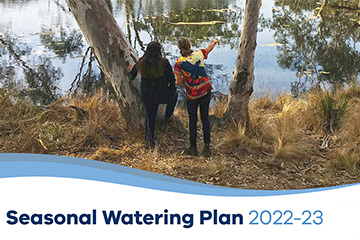Floods trigger fish breeding frenzy
06 December 2016
Minor flooding in rivers and creeks across the Goulburn Broken catchment have triggered a native fish breeding frenzy.
Goulburn Broken Catchment Management Authority (CMA) Environmental Water Manager Simon Casanelia said recent monitoring conducted as part of the Commonwealth Environmental Water Holder's Long Term Intervention Monitoring project found good numbers of golden and silver perch spawned in response to the recent natural high flows along the lower Goulburn River.
"We planned an environmental flow along the lower Goulburn River last month (November) to stimulate golden perch migration and spawning but cancelled it due to the high natural river flows that occurred during late winter and spring," Mr Casanelia said.
"So it's great news that nature has run its course and triggered a spawning event."
Golden perch also spawned after natural flooding in the lower Goulburn River in 2010 and more recently after environmental water deliveries in 2013 and 2014.
Murray cod numbers are also looking healthy, with Murray cod larvae recorded in the Goulburn River as well as the lower Broken Creek by Arthur Rylah Institute staff during monitoring
"The larvae is a good indicator that Murray cod recently bred," Mr Casanelia said. "This also indicates that the lower Broken Creek's dissolved oxygen levels have returned to normal levels after dropping to critically low levels at Rice's Weir near Barmah a few weeks back."
Low dissolved oxygen levels can stress fish. The low dissolved oxygen levels in Rice's Weir were due to leaf litter and other debris being washed into the creek after heavy rain. Goulburn Broken CMA worked with Goulburn Murray Water to co-ordinate delivery of environmental water to help improve the water quality. Environmental water delivery will continue until the end of the irrigation season to maintain water quality and provide habitat and shelter for native fish.
"Many of the smaller creeks in the catchment, that had stopped flowing or had very low flows as a result of the dry hot weather earlier in the year, have also benefited from the recent record rainfall," Mr Casanelia said.
"For example a small number of young flat-headed galaxias were recently recorded in Cornella Creek. This indicates that this nationally endangered species has successfully bred, despite the recent dry and then flood conditions – proving they're pretty resilient. Their presence also shows how important it is to provide refuge during drier times – whether it's through delivery of environmental water, placing snags in the creek, protecting drought refuge pools or landholders carrying out revegetation works along their river frontages."
Note: The LTIM has been established by the Commonwealth Environmental Water Holder to monitor and evaluate the ecological outcomes of environmental water use. The LTIM project is being implemented over five years (2014 to 2019) at seven selected areas across the Murray Darling Basin, including the lower Goulburn River.
Further Information
Goulburn Broken CMA
E: reception@gbcma.vic.gov.au
Tel: 03 5822 7700.


